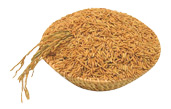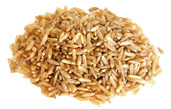| Rice, common name for about 19 species of annual herbs, of the grass family. Common rice is the only species of importance to human beings. It is native to south-east Asia and has been cultivated for more than 7,000 years. It thrives in areas of considerable warmth and moisture and reaches a height of about 1m (3 ft), with flowers bearing six stamens and a solitary pistil. The fruit, a grain, is produced on a nodding of the stalk. When the grain is ripe, Rice resembles the oat plant. The white endosperm is enclosed by a layer of bran surrounded by a brown husk. |  | |
| Rice grains are extensively used as human food; rice constitutes the principal food of half the human race. It is primarily consumed after processing as polished rice. The bran or germ which comprises 10% of whole rice is removed during the polishing process.. White rice, which is rice from which the nutritious bran has been removed, is an inferior food. A diet of white rice causes such deficiency diseases as Beriberi. Recognition of the nutritional value of the rice bran has led to some increase in the consumption of brown rice, which is the rice grain from which the bran has not been removed. Brown rice is a very good source of manganese and also a good source of other minerals like magnesium and selenium. Almost 11 nutrients are lost during the processing of white rice. Process to get polished white rice from brown rice destroys 80% thiamin, 67% niacin, 90% vitamin B6, 60% iron, half of phosphorous and manganese and all of essential fatty acids and dietary fiber. According to law in United States fully processed polished white rice should be enriched with thiamin, niacin and iron, however this enrichment cannot replace the loss of around 11 nutrients and are not the same as found in the original version. | ||
| Brown rice is unpolished rice; i.e., the bran layer of the grain is not removed through polishing as is done with white rice. Thus, it is more nutritious than polished rice and is becoming popular among health conscious people.Modern researches have confirmed the beliefs of ancient oriental folk physicians that eating brown rice is a source of serenity and tranquility. It has been shown to contain all the elements need for the maintenance of good health |  | |
| Rice contains mostly “Starch” as high as 72% on w/w basis. Due to the high starch content, it is the most favoured “raw material” for alcoholic beverages since centuries in different parts of the world.Different varieties of Rice has different aromatic component in it, which becomes the main source of wine making & produces wine with specific aroma & name. It is “Sake” in Japan & “Tanimura” in Philippines. “Vodka” the famous drink of “Russia” is made from rice as well. | ||
| Apart from wine, rice can be good source for other alcoholic beverages, Now with depleting “Crude Petroleum” reserves world over, “Ethanol” is seen as alternative fuel & rice can be best source. The changed dietary habits of the new generation has appeared to increase the risk of coronary heart disease and heart attacks especially in over – weight people. Common features of a metabolic syndrome include visceral obesity (the “apple shaped” body), low levels of protective HDL cholesterol, high triglycerides, and high blood pressure. | ||
| Lately realizing this Govt. of India has put this industry under “Ministry of Food Processing” to specially focus on to increase its consumption as food. | ||
Medical Importance | ||
| Rice bran is an important source of rice oil and other phyto chemicals which possess anti oxidative and disease fighting properties. Traditionally, rice-bran products have found applications in agricultural, food and cosmetic industries. Now, medicinal research has unraveled scientific evidence supporting a role for key components of rice in health maintenance and disease prevention. | ||
| Health and nutrients from brown rice | ||
|  | |
| How to cook Brown Rice properly ? | ||
| However, when brown rice is used in cooking, the bran layer enveloping the grain is an impediment to the entry of water. Therefore, one needs to extend the cooking time to soften the grain more than polished rice, or soak the brown rice in tap water for about 30 minutes before cooking, and use more water for cooking. Normally, the proportion of brown rice to water is 1:2 (1 cup brown rice to 2 cups water). This ratio of course can be adjusted according to the desired softness. | ||